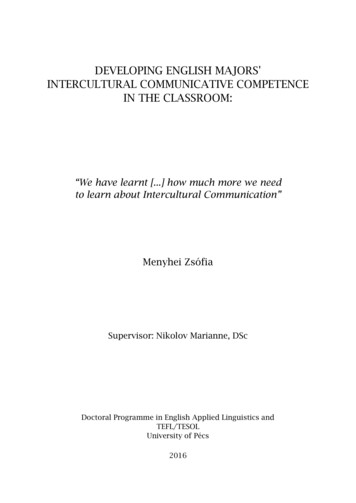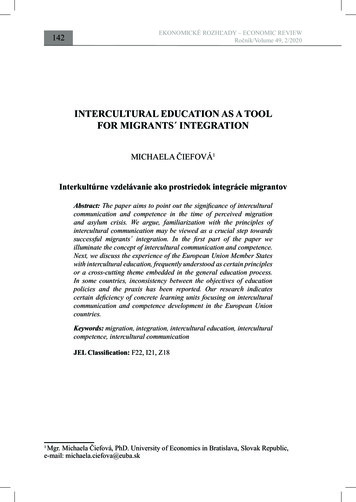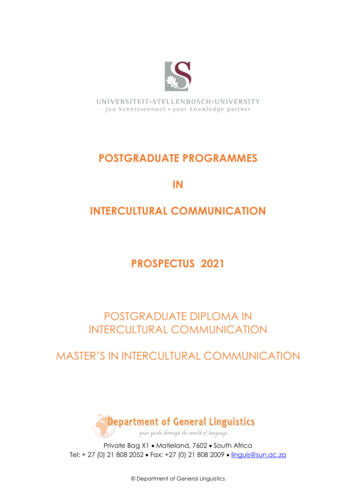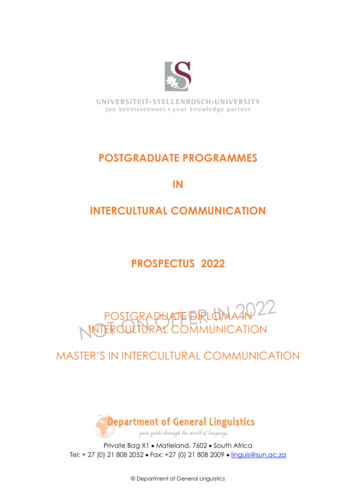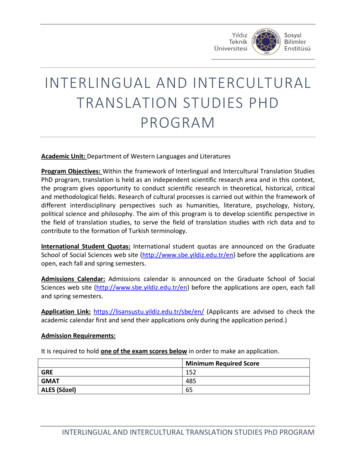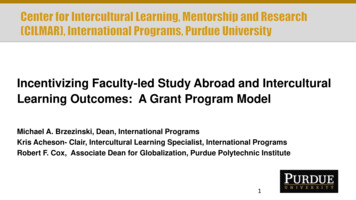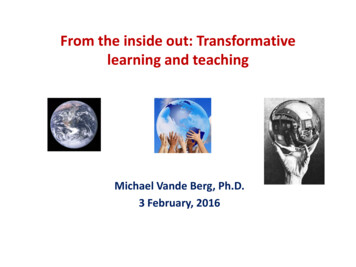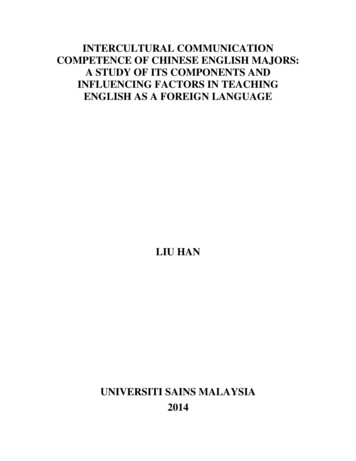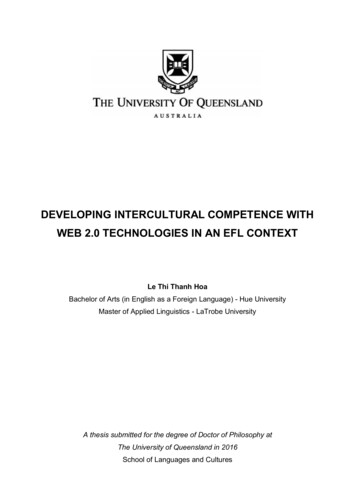
Transcription
DEVELOPING INTERCULTURAL COMPETENCE WITHWEB 2.0 TECHNOLOGIES IN AN EFL CONTEXTLe Thi Thanh HoaBachelor of Arts (in English as a Foreign Language) - Hue UniversityMaster of Applied Linguistics - LaTrobe UniversityA thesis submitted for the degree of Doctor of Philosophy atThe University of Queensland in 2016School of Languages and Cultures
AbstractIntercultural English-as-a-Foreign-Language (EFL) education requires a suitabletheoretical framework for the teaching of intercultural competence (IC). On the one hand,existing conceptualizations of IC in the intercultural communication literature are notalways helpful for language teachers; on the other, the language teaching literatureaddresses the inclusion of IC to a limited extent (Baker, 2015; Porto, 2013). By itsinterdisciplinary nature, intercultural EFL education requires a combination of compatibletheoretical approaches, and existing theories of IC should be adapted and combinedbased on their complementarity. Accordingly, a study on IC in EFL contexts might needthe integration of a developmental model (Bennett, 1993) and a component theory of IC(Byram, 1997); moreover, it should foreground language elements by referring to linguistictheories to understand the role of language in IC development.In the light of this argument, the present project adapted both Byram (1997) and Bennett(1993) as theoretical frameworks and investigated IC development in reference tofunctional linguists’ APPRAISAL (Martin & White, 2007) to gain insights into the affectivedimension encoded in informants’ language. Moreover, in response to the need of anauthentic environment for teaching intercultural communication in a university-level EFLcontext in Vietnam, the project explored the extent to which a Web 2.0 mediated learningdesign could contribute to EFL learners’ IC development.Employing a design-based research methodology, this study involved creating a Web 2.0mediated IC learning design for university-level EFL learners in Vietnam, testing andrefining it. Specifically, based on the pedagogical context of the case study and existingprinciples of intercultural education, a Facebook-mediated IC learning design was createdand integrated into the existing course, “Intercultural Communication”. It entailed threeiterative learning cycles of written chat between students and guests from other culturesabout cultural issues of interest to them, students’ written reflection on what they learnedand discussion with peers, all of which were posted on Facebook. The researcherimplemented this design over fifteen weeks and collected data from a nineteen studentclass. The data included the material posted on Facebook, follow-up interviews with focalstudents and student evaluations.With regard to theorizing intercultural communication, the study shows that the students’IC development was a process of languaging to create changes in cognition, affect andskills. Specifically, they used their linguistic and multimodal resources to articulate,formulate, exchange and create knowledge in chats with the guests and with peers, and ini
their written reflections. Via these processes they developed their skills of discovery andinteraction, and of interpreting and relating cultural phenomena. Languaging was also aprocess of expressing feelings and negotiating stances. Additionally, the process ofchange involved balancing cognitions and shifting feelings associated with thosecognitions. It was influenced by situational factors and personal traits. Accordingly, thestudents’ trajectories of IC development shifted dynamically through different states ofethnocentrism to a state of relativizing values underlying cultural difference.In pedagogical terms, the students’ changes in knowledge, feelings and skills suggest thatthe proposed learning design contributed to their IC development. The constructivistpedagogy underlying the design and the mediation of Web 2.0 facilitated the students’reflective thinking. Specifically, Facebook-mediated chats with guests gave the studentsintercultural experiences, made previously invisible cultural differences more visible, andthus triggered the students’ awareness of them. The students’ changes in IC wereattributed to their critical reflection which was scaffolded by teacher preparation, guidanceand feedback, by peers cooperation, and by empowerment from the guests. However, thefindings disclose several constraints of Web 2.0 and weaknesses of the learning design.The most salient are time management, and provision of feedback. Moreover, there mightbe a mismatch between Vietnamese students’ educational expectations and values, andWestern constructivist pedagogy involved in the learning design.Theoretically, the study offers insights into less-investigated aspects of IC and proposes auseful conceptualization of IC in EFL contexts. First, it illuminates a range of affectivestates associated with different cognitive configurations that are overlooked in commonlycited theories (e.g., Bennett, 1993; Byram, 1997). It also sheds light on the phenomena oflanguaging and of cognitive balancing in cognitive and affective adaptation which havebeen criticized as under-investigated. Second, it addresses the major weaknesses ofexisting IC conceptualizations, namely abstractness and lack of awareness of linguisticissues, by providing linguistic and non-linguistic evidence of IC development. Drawing onfindings about the interaction of these dimensions, individual trajectories are uncovered,revealing how EFL learners construct IC via languaging. Accordingly, the study proposes amore comprehensive model of IC that can be integrated into an EFL curriculum.Moreover, the project generates pedagogical principles for Web 2.0 mediated IC learningdesigns.Practically, the study demonstrates an example of how to create a Web 2.0 mediated IClearning design which can be flexibly adapted in similar contexts.ii
Declaration by authorThis thesis is composed of my original work, and contains no material previously publishedor written by another person except where due reference has been made in the text. Ihave clearly stated the contribution by others to jointly-authored works that I have includedin my thesis.I have clearly stated the contribution of others to my thesis as a whole, including statisticalassistance, survey design, data analysis, significant technical procedures, professionaleditorial advice, and any other original research work used or reported in my thesis. Thecontent of my thesis is the result of work I have carried out since the commencement ofmy research higher degree candidature and does not include a substantial part of workthat has been submitted to qualify for the award of any other degree or diploma in anyuniversity or other tertiary institution. I have clearly stated which parts of my thesis, if any,have been submitted to qualify for another award.I acknowledge that an electronic copy of my thesis must be lodged with the UniversityLibrary and, subject to the policy and procedures of The University of Queensland, thethesis be made available for research and study in accordance with the Copyright Act1968 unless a period of embargo has been approved by the Dean of the Graduate School.I acknowledge that copyright of all material contained in my thesis resides with thecopyright holder(s) of that material. Where appropriate I have obtained copyrightpermission from the copyright holder to reproduce material in this thesis.iii
Publications during candidatureNo publications.Publications included in this thesisNo publications included.Contributions by others to the thesisNo contributions by others.Statement of parts of the thesis submitted to qualify for the award of another degreeNone.iv
AcknowledgementsFirst of all, I would like to express my deep gratitude to my supervisors at the University ofQueensland for their valuable advice, tolerance and support in many ways without which Icould not have reached the end of my PhD journey. For me, their guidance is also awonderful example of how a teacher can help their students construct their knowledge andunderstanding of the issues under study. Despite many limitations in this thesis due to mycompetence and other factors, I have learned a great deal from their expertise and ways ofguiding me in learning. Accordingly I have grown professionally and personally during myPhD candidature. I am also thankful to Dr Paul Moore for his insightful comments thathelped to me shape my arguments further, and for the rewarding experience I had as atutor in his course of Intercultural Communication at the University of Queensland.I am particularly indebted to all the students and the guest speakers who voluntarilyparticipated in this project. They provided me with rich information and were generous inoffering help and clarification whenever I needed it. My thanks also go to my co-teacher inthe course, and the staff from the Training Department who helped me schedule theclasses and allowed me access the students’ end-of-course evaluation.I am grateful to the Australian government and the University of Queensland for theirgenerosity in offering me the International Postgraduate Research Scholarship and the UQCentennial Scholarship. I would also like to thank the staff at the School of Languages andCultures for their support during my candidature, especially Esther Lovely for her help withthe references. It was also my pleasure to have company of kind-hearted housemates andother PhD students in my office.Finally, this humble work is dedicated to my family, particularly my husband anddaughters, with my gratitude for their endless support and love.v
KeywordsIntercultural communication, Intercultural competence, Web 2.0, Facebook, English-as-aForeign-Language (EFL), VietnameseAustralian and New Zealand Standard Research Classifications (ANZSRC)ANZSRC code: 200401 Applied Linguistics and Educational Linguistics, 50%ANZSRC code: 200209 Multicultural, Intercultural and Cross-cultural Studies, 30%ANZSRC code: 200102 Communication Technology and Digital Media Studies 20%Fields of Research (FoR) ClassificationFoR code: 2002 Cultural Studies, 50%FoR code: 2004 Linguistics, 50%vi
Table of ContentsAbstract. iDeclaration by author. iiiAcknowledgements. vTable of Contents . viiList of Tables . xiiList of Figures . xiiiList of Abbreviations used in the thesis. xivChapter 1 INTRODUCTION.11.1 Introduction.11.2 Background and context of the study .11.3 Aims and research questions .31.4 Structure of the thesis.4Chapter 2 LITERATURE REVIEW.62.1 Introduction.62.2 The intercultural speaker .62.3 Intercultural competence .82.3.1 Conceptualization of IC .82.3.2 Characteristics of intercultural competence.92.3.2.1 Intercultural Competence as multidimensional: Byram’s model of IC.92.3.2.2 Intercultural Competence as developmental: Bennett’s Developmental Modelof Intercultural sensitivity (DMIS).142.3.2.3 Intercultural Competence as contextual .182.3.2.4 Intercultural competence as idiosyncratic.202.3.3 Summary .202.4 Adaption of models for the present project .212.4.1 The compatibility of Byram’s theory of teaching and learning IC and Bennett’sDMIS .212.4.2 Perspectives complementary to the two theories .222.4.3 Summary .282.5 The teaching and learning of IC.292.5.1 Developmental constructivist approach to IC teaching and learning .292.5.2 Five principles: Active process of teaching and learning IC .29vii
2.5.2.1 Active construction .302.5.2.2 Making connections.312.5.2.3 Social interaction .312.5.2.4 Reflection .322.5.2.5 Responsibility .322.5.2.6 Summary .322.5.3 IC learning in practice: key characteristics .332.5.3.1 Experience .332.5.3.2 Reflection .342.5.3.3 Other characteristics of IC learning .362.5.4 Summary .372.6 Web-mediated teaching and learning of IC.372.6.1 Web technology affordances .372.6.2 Facebook as adapted web technology in education.392.6.3 Web technologies and IC learning in practice .392.6.4 Principles for Web-mediated IC learning .402.6.4.1 Pedagogical principles .402.6.4.2 Technological principles .402.6.4.3 Sequence of learning activities.412.6.5 Summary .422.7 Conclusion.42Chapter 3 METHODOLOGY.433.1 Introduction.433.2 Design-based research .433.3 DBR and Web 2.0 mediated IC learning.453.4 Research design.473.4.1 Four DBR phases.473.4.2 Phase 1 .483.4.2.1 Data collection.483.4.2.2 Data analysis and findings.493.4.3 Phase 2 .503.4.3.1 Proposed Facebook-mediated IC learning design.503.4.4 Phase 3 .51viii
3.4.4.1 Research methods .513.4.4.2 Participants.523.4.4.3 Implementation of the proposed learning design.533.4.4.4 Data collection.553.4.4.5 Data analysis.603.4.5 Phase 4 .613.5 Reliability and validity .623.5.1 Explicit conceptual framework .623.5.2 Triangulation.623.5.3 Inductive and deductive data analysis .623.5.4 Full description .633.5.5 Member check.633.6 Summary of chapter 3 .63Chapter 4 THE STUDENTS’ DEVELOPMENT OF INTERCULTURAL COMPETENCE .644.1 Introduction.644.2 A report on the whole class .644.2.1 The students’ cognitive development .644.2.1.1 Cognitive development in chats.654.2.1.2 Cognitive development in written reflections .714.2.1.3 Cognitive development in peer discussions.784.2.1.4 Discussion of the students’ cognitive development in relation to existingconceptualizations of IC and relevant theories. .834.2.1.5 Overall remarks about the students’ cognitive development .874.2.2 The students’ development of skills.884.2.2.1 The students’ development of skills of interpreting and relating .884.2.2.2 The students’ development of skills of discovery and interaction .894.2.3 The students’ attitudinal changes .904.2.3.1 The students’ attitudinal changes in the process of learning with Guest 1 .914.2.3.2 The students’ attitudinal changes in the process of learning with Guest 2 .984.2.3.3 The students’ attitudinal changes in the process of learning with Guest 3 .1074.2.3.4 Conclusion to section 4.2 .1174.3 Two focal students’ trajectories of IC development .1184.3.1 Thúy’s trajectory of IC development .119ix
4.3.1.1 Thúy’s IC development in the process of learning with Guest 1 .1194.3.1.2 Thúy’s development of IC in the process of learning with Guests 2 and 3 .1234.3.2 Trang’s trajectory of IC development.1284.3.2.1 Trang’ changes in IC development in the process learning with Guest 1 .1284.3.2.2 Trang’s IC development in the process of learning with Guests 2 and 3 .1354.4 Summary of the students’ IC development .1404.4.1 Languaging in cognitive and affective processes .1404.4.2 IC development .1414.4.2.1 IC development in the process of learning with Guest 1 .1414.4.2.2 IC development in the process of learning with Guests 2 and 3 .1424.4.3 Visualization of IC development in a Web 2.0 mediated intercultural EFL context.143Chapter 5 THE INFLUENCE OF THE LEARNING DESIGN.1465.1 Introduction.1465.2 The influence of the contact with the guests from other cultures .1465.2.1 In the students’ development of knowledge .1465.2.2 In the students’ development of skills.1495.2.3 In the students’ development of attitudes .1515.2.4 Discussion and conclusion .1545.3 The importance of written reflection.1595.3.1 In the students’ development of knowledge .1595.3.2 In the students’ development of skills .1605.3.3 In the students’ development of attitudes .1615.3.4 Discussion and conclusion .1625.4 The importance of peer discussion.1645.4.1 In the students’ development of knowledge .1645.4.2 In the students’ development of skills .1655.4.3 In the students’ development of attitudes .1665.4.4 Discussion and conclusion .1665.4.5 Summary of the influence of the teaching and learning activities .1675.5 Mediation and scaffolding in the teaching and learning activities .1685.5.1 The mediation of Web 2.0 technologies: affordances and constraints .1695.5.2 Scaffolding in the learning activities .170x
5.5.3 Revisions of the learning cycles in the implementation .1735.5.4 Discussion and conclusion .1755.6 A revised Web 2.0 mediated IC learning design.1785.6.1 Pedagogical principles .1785.6.2 A revised Web 2.0 mediated IC learning design.1795.6.3 A revised Web 2.0 mediated IC learning design for the local context.1805.7 Conclusions to chapter 5 .181Chapter 6 CONCLUSION .1826.1 Introduction.1826.2 Overview of the study .1826.3 Towards conceptualizing IC and IC development in an EFL context .1836.3.1 Summary of EFL learners’ IC development.1836.3.2 Significance of the findings about IC development.1856.4 Towards pedagogical principles of Web 2.0 mediated IC teaching and learning in anEFL context .1876.4.1 Summary of the influence of the Web 2.0 mediated IC learning design .1876.4.2 Significance of the findings about the influence of the Web 2.0 mediated IClearning design .1916.5 Implications.1926.5.1 Implications of IC conceptualization for research and education.1926.5.2 Implications of research design .1956.5.3 Implications of creating and implementing a Web 2.0 mediated IC learningdesign.1966.6 Limitations .1986.7 Suggestions for further studies .1996.8 Final remarks.200REFERENCES .202Appendix 1.214Appendix 2 .221Appendix 3.223xi
List of TablesTable 2-1. Components of intercultural competence (Byram, 1997, pp. 57-64).10Table 3-1. Implications of a DBR approach for research into Web 2.0 mediated IC learning.46Table 3-2. Phases of the study mapped against typical elements of a research report(Adapted from Herrington et al., 2007).48Table 3-3. Data source and language.55Table 4-1. Types of knowledge and types of questions the students asked. .65Table 4-2. Types of knowledge about the other culture students reported in the process oflearning with the three guests. .71Table 4-3. Types of knowledge in peer discussions. .78Table 4-4. Emergence of skills in reflections and peer discussions. .89Table 4-5. IC development in an intercultural EFL education context. .145xii
List of FiguresFigure 2-1. Byram’s Model of Intercultural Communicative Competence (Byram, 2009, p.323).10Figure 2-2. The Developmental Model of Intercultural Sensitivity (J. M. Bennett & Bennett2004, p. 153).
Intercultural communication, Intercultural competence, Web 2.0, Facebook, English-as-a-Foreign-Language (E FL), Vietnamese Australian and New Zealand Standard Research Classifications (ANZSRC) ANZSRC code: 200401 Applied Linguistics and Educational Linguistics, 50% ANZSRC code: 200209 Multicultural, Intercultural and Cross-cultural Studies, 30%
